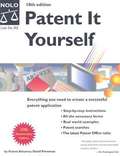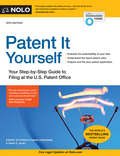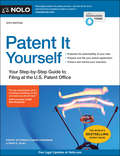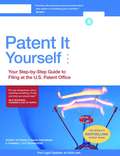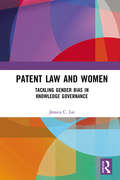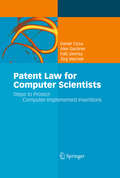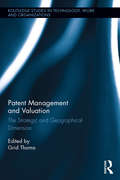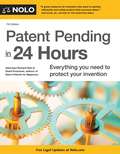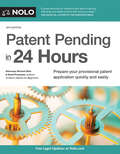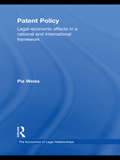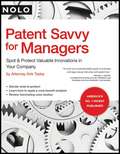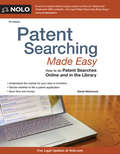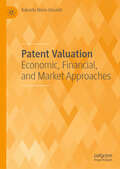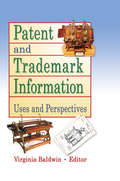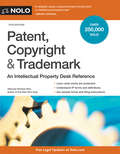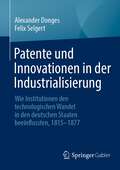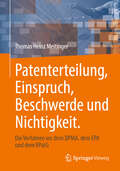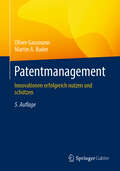- Table View
- List View
Patent It Yourself (10th edition)
by David PressmanPressman, a patent attorney and inventor, offers a guide to the patent process. He explains what patents and other intellectual property are, each step in the process of obtaining a US patent, how and when to file an application, how to document an invention, and requirements and procedures abroad, and provides reproducible and downloadable forms. He also discusses alternative and supplementary forms of protection, such as trade secrets, copyrights, trademarks, and unfair competition law, as well as how to commercially evaluate, market, and license an invention. This edition includes the latest US Patent and Trademark Office rules and forms and covers electronic filing, combination inventions, and other changes to technical filing rules. It covers recent court cases, termination of the PTO's Document Disclosure Program, the lack of patentability of transitory electronic signals, free patent searching systems, new forms, claiming copyright in a specification or drawing, new rules regarding claims limitations and continuation applications.
Patent It Yourself: Your Step-by-Step Guide to Filing at the U.S. Patent Office
by David Pressman David E. BlauFor 30 years, Patent It Yourself has guided hundreds of thousands of inventors through the process of getting a patent, from start to finish. Patent attorneys David Pressman and Thomas J. Tuytschaevers provide the latest information, forms, and clear instructions to help you: conduct a patent search the right way evaluate your idea’s commercial potential file a provisional patent application to get “patent pending” status prepare a patent application focus on your patent application’s claims respond to patent examiners get your drawings done right protect your rights in foreign countries deal with infringers, and market and license your invention. Thoroughly updated to reflect the latest changes in intellectual property law, this edition provides the latest U.S. Patent and Trademark Office rules and forms. The 18th edition covers the latest implications of the first-to-file rules created by the America Invents Act.
Patent It Yourself: Your Step-by-Step Guide to Filing at the U.S. Patent Office
by David Pressman David E. BlauProtect and profit from your invention For 35 years, Patent It Yourself has guided hundreds of thousands of inventors through the process of getting a patent, from start to finish. Patent attorneys David Pressman and David E. Blau provide the latest information, forms, and clear instructions to help you: conduct a patent search the right way evaluate your idea’s commercial potential file a provisional patent application to get “patent pending” status prepare a patent application focus on your patent application’s claims respond to patent examiners get your drawings done right protect your rights in foreign countries deal with infringers, and market and license your invention. The 20th edition covers the latest patent filing rule changes, including the most recent implications of the America Invents Act first-to-file rules. With downloadable forms: All essential forms, including a Nondisclosure Agreement, Patent Searcher’s Worksheet, and Design Patent Application are included in the book and are available for download (details inside).
Patent It Yourself: Your Step-by-Step Guide to Filing at the U.S. Patent Office
by David Pressman Thomas TuytschaeversAttorney David Pressman and updater Thomas Tuytschaevers take you through the entire patent process, providing scrupulously updated information and clear instructions to help you: determine if you can patent your invention understand patent law evaluate the commercial potential of your idea perform your own patent search file a provisional patent application prepare a formal patent application respond to patent examiners amend an application enforce and maintain your patent market and license your invention Thoroughly updated to reflect the latest changes in intellectual property law, this edition provides the latest U.S. Patent and Trademark Office rules and forms. It includes up-to-date discussions of the new "first to file" rule, which has to revolutionized patent law.
Patent Law and Women: Tackling Gender Bias in Knowledge Governance
by Jessica C. LaiThis book analyses the gendered nature of patent law and the knowledge governance system it supports. The vast majority of patented inventions are attributed to male inventors. While this has resulted in arguments that there are not enough women working in science, technology, engineering and mathematics, this book maintains that the issue lies with the very nature of patent law and how it governs knowledge. The reason why fewer women patent than men is that patent law and the knowledge governance system it supports are gendered. This book deconstructs patent law to reveal the multiple gendered binaries it embodies, and how these in turn reflect gendered understandings of what constitutes science and an invention, and a scientist and an inventor. Revealing the inherent biases of the patent system, as well as its reliance on an idea of the public domain, the book argues that an egalitarian knowledge governance system must go beyond socialised binaries to better govern knowledge creation, dissemination and maintenance. This book will appeal to scholars and policymakers in the field of patent law, as well as those in law and other disciplines with interests in law, gender and technology.
Patent Law for Computer Scientists
by Jörg Machek Daniel Closa Alex Gardiner Falk GiemsaPatent laws are different in many countries, and inventors are sometimes at a loss to understand which basic requirements should be satisfied if an invention is to be granted a patent. This is particularly true for inventions implemented on a computer. While roughly a third of all applications (and granted patents) relate, in one way or another, to a computer, applications where the innovation mainly resides in software or in a business method are treated differently by the major patent offices in the US (USPTO), Japan (JPO), and Europe (EPO). The authors start with a thorough introduction into patent laws and practices, as well as in related intellectual property rights, which also explains the procedures at the USPTO, JPO and EPO and, in particular, the peculiarities in the treatment of applications centering on software or computers. Based on this theoretical description, next they present in a very structured way a huge set of case studies from different areas like business methods, databases, graphical user interfaces, digital rights management, and many more. Each set starts with a rather short description and claim of the "invention", then explains the arguments a legal examiner will probably have, and eventually refines the description step by step, until all the reservations are resolved. All of these case studies are based on real-world examples, and will thus give an inexperienced developer an idea about the required level of detail and description he will have to provide. Together, Closa, Gardiner, Giemsa and Machek have more than 70 years experience in the patent business. With their academic background in physics, electronic engineering, and computer science, they know about both the legal and the subject-based subtleties of computer-based inventions. With this book, they provide a guide to a patent examiner's way of thinking in a clear and systematic manner, helping to prepare the first steps towards a successful patent application.
Patent Management and Valuation: The Strategic and Geographical Dimension (Routledge Studies in Technology, Work and Organizations)
by Grid ThomaResearch on patent valuation has become increasingly important in academic and policy circles in the last few decades. In part, this is the outcome of the wide consensus that innovation is a crucial ingredient for growth at various levels. On the other hand, there has also been an overcoming of growth models unilaterally focused on technological-oriented approaches. This book presents novel and original research on patent value determinants, which are intrinsic or extrinsic to the innovator's business model. Grid Thoma has undertaken a long study on the strategic factors affecting patent valuation, bringing extensive quantitative evidences across various geographical and institutional contexts. Beforehand, the valuation of the patent real options is appraised when the innovator can postpone the additional investment required for the patent's successful exploitation. Then, he analyses what other complemental IP strategies are combined with patenting that in turn directly affect the value of patents. Moreover, the book scrutinizes the so-called 'strategic patenting' hypothesis according to which innovators obtain patents for other reasons beyond gaining IP protection. A second order of strategic factors affecting the value of patents resides at the outset of the invention process. These are constituted by knowledge spillovers, which are typically mediated by the local geographical context where the invention process takes place. The analysis shows that the contribution of knowledge spillovers from business and nonbusiness organizations to the value of the patented R&D constitutes a relevant aspect for an innovator's decision making. This thoughtful, cutting-edge research book is vital reading for researchers, academics, and policy decision makers in the area of in market valuation, management of technology, innovation management, and economic geography.
Patent Management: Protecting Intellectual Property and Innovation (Management for Professionals)
by Oliver Gassmann Martin A. Bader Mark James ThompsonThis book provides an overview of the common concepts and building blocks of patent management. It addresses executives in the areas of innovation, R & D, patent and intellectual property management as well as academics and students.The authors give valuable information on the characteristics of patent and intellectual property management, based on the collaboration with companies and organizations from Europe, China, Japan, Argentina, Brazil, India, Canada and the US.A reference for managers who want to bring information technology innovation with a clear intellectual property strategy to the market. A very readable book. Thomas Landolt, Managing Director, IBMA really comprehensive, all-in book about Patents – strategy, value, management and commercialization. And not forgetting what they are for – foster innovation.Dr. Joerg Thomaier, Head of IP Bayer Group
Patent Markets in the Global Knowledge Economy
by Thierry Madiès Thierry Madiès Dominique Guellec Jean-Claude Prager Dominique GuellecThe development of patent markets should allow for better circulation of knowledge and more efficient allocation of technologies at a global level. However, the beneficial role of patents has recently come under scrutiny by those favouring 'open' innovation, and important questions have been asked, namely: How can we estimate the value of patents? How do we ensure matching between supply and demand for such specific goods? Can these markets be competitive? Can we create a financial market for intellectual property rights? In this edited book, a team of authors addresses these key questions to bring readers up to date with current debates about the role of patents in a global economy. They draw on recent developments in economic analysis but also ground the discussion with the basics of patent and knowledge economics. Striking a balance between institutional analysis, theory and empirical evidence, the book will appeal to a broad readership of academics, students and practitioners.
Patent Pending in 24 Hours
by Richard Stim David PresmanEverything you need to protect your invention now The provisional patent application (PPA) is a quick, inexpensive and legal way to claim your invention--and buy yourself time to determine whether it's worthwhile to pursue a regular patent. Learn how to: conduct a patent search online complete all the necessary forms evaluate potential hurdles prepare informal drawings file your application, and file a new PPA to reflect modifications. The book also includes important legal forms to help you preserve your rights when showing or selling your invention: nondisclosure agreement patent assignment prototype-maker agreement joint-ownership agreement The 7th edition incorporates changes from the "America Invents Act," as well as recent revisions to patent rules and regulations. Thousands of people have used Patent Pending in 24 Hours successfully. You can, too!
Patent Pending in 24 Hours
by Richard Stim David PresmanEverything you need to protect your invention now Ready to stamp "patent pending" on your invention? Then you need to file a provisional patent application (PPA), an inexpensive way to claim your invention - and buy yourself time to determine whether it's worthwhile to pursue a regular patent. With Patent Pending in 24 Hours, you will learn how to: conduct a patent search online complete all the necessary forms evaluate potential hurdles prepare informal drawings file your application, and file a new PPA to reflect modifications The new edition covers the latest implications of recent federal patent law reform for PPA applicants.
Patent Policy: Legal-Economic Effects in a National and International Framework (The\economics Of Legal Relationships Ser.)
by Pia WeissIntellectual property rights have become increasingly important for our modern economies in recent years. Although the entire patent system has a profound effect on the decision of firms of whether to conduct research and at which volume, patent law is the heart of the entire patent system. Therefore, this book focuses on the economic effects of certain provisions in patent law by using economic models dedicated to patent policy. The first part of the book presents a brief overview over the history of patent systems and introduces the main components of modern patent systems. A short introduction of the principal provisions of US patent law constitutes the centre of the subsequent analysis as it serves as a link between law and economics. The second part presents core economic models for central provisions, collecting the most fundamental results in a national framework in the field of literature. Part three is concerned with selected provisions of patent law in an international framework. It provides valuable insights into the situation of developing countries which are the chief recipients of technology transfers. Patent Policy will be of interest to researchers interested in the field of modelling patent policy. It can be also used as supplementary text in courses in Industrial Organization, Innovation Economics and Law and Economics.
Patent Savvy for Managers
by Kirk TeskaFind out how to spot and protect your company's innovations! When it comes to patents, there's no room for mistakes. Making the wrong decision can send a business into an irreversible tailspin, costing your company millions of dollars -- not to mention jobs. Luckily, you have a friendly resource to help you out: Patent Savvy for Managers Loaded with fascinating case studies, this book is an essential asset for anyone entrusted with protecting a company's products or processes. Patent Savvy for Managers provides all the information you need to: identify and evaluate company patents organize patent committees work with patent attorneys read and understand patents Friendly, informative and straight to the point, Patent Savvy for Managers offers the ideal blend of legal information, practical insights and real-world examples.
Patent Searching Made Easy: How to do Patent Searches Online and in the Library
by David HitchcockInventor? Find out if you're the first to file a patent, online and in the library In the past, if you wanted to assess the novelty of an idea, you had to wade through the patent database at the U.S. Patent and Trademark Office (PTO) in Virginia -- or hire a lawyer to do a patent search for $500 and up. The cost and inconvenience of these searches often meant that good ideas were left to rot on the vine. In Patent Searching Made Easy, find the plain-English information you need to: verify the patent status of an idea search Patent and Trademark Depository Libraries use online patent search services A physicist, engineer, and patent searching expert, author David Hitchcock gives you the vocabulary, instructions and strategies you need to search for a patent quickly and easily. He explains how the PTO classifies different types of inventions, so that you can assign your idea to the right class, compare it to related ideas, and then determine if it's novel enough to qualify for a patent. Patent Searching Made Easy shows you how do patent searches yourself, on the Internet, at little or no cost. Plus, you'll learn how to: prepare for online searches with the right hardware, software and computer skills access online patent searching resources narrow online searches with keywords and Boolean logic perform database searches at Patent and Trademark Depository Libraries (PTDLs) do microfiche searches at PTDLs search fee-based patent databases on the Internet search international patent offices, and do advanced searches at the PTO and PTDL. Written for both inventors and business owners interested in expanding their product line through the license, distribution or manufacture of other people's ideas, Patent Searching Made Easy is the easiest way for you to determine the answer to that all-important question, "Am I the first?"
Patent Trolling
by Lauren H. Cohen Scott Duke Kominers Umit G Gurun George Hou"In the United States, as in many other countries, inventors are granted patents that give them sole rights of commercialization—and the right to block commercialization of arguably similar inventions—for a fixed period of time (20 years).1 By allowing inventors to capture the value they create, patents incentivize inventors to undertake the large upfront investments innovation requires."
Patent Valuation: Economic, Financial, and Market Approaches
by Roberto Moro-ViscontiIn today&’s knowledge-driven economy, patents are more than legal protections—they are strategic assets shaping innovation, investment, and competition. This book provides a comprehensive framework for patent valuation, integrating economic, financial, and market approaches with emerging technologies such as AI, blockchain, and tokenization. Patents play a central role in diverse industries, from pharmaceuticals and biotechnology to high-tech and green innovation. However, valuing these assets requires navigating complex legal, economic, and strategic factors. This book explores the methodologies used to assess patent worth, including cost-based, market-based, and income-based approaches, while addressing critical challenges such as litigation risks, regulatory considerations, and monetization strategies. Featuring real-world cases and industry-specific insights, this book is an essential guide for investors, innovators, policymakers, and academics looking to unlock the economic potential of patents. Whether you're managing an IP portfolio, securing venture capital, or exploring the impact of ESG factors on patent valuation, this book provides the tools and knowledge to navigate the evolving landscape of intellectual property in the global economy.
Patent and Trademark Information: Uses and Perspectives
by Virginia Ann BaldwinDiscover new techniques for researching patents and trademarks! Patent and Trademark Information: Uses and Perspectives addresses an essential yet undervalued and often underused class of scientific and technical information. Library staff, information specialists, corporation heads and administrators, inventors, school faculty, scientists, engineers, and engineering, science and library students will gain valuable insight on historical research, practical applications, and the availability and accessibility of patenting authorities. This book focuses on methods for searching international patents and trademark information for patrons of the library using the Internet, databases, and other sources. This book contains tips and nuts-and-bolts advice from experienced librarians who either practice in patent and trademark depository libraries or are experts in researching patents for library patrons. Their advice will help you navigate decision points and search paths for locating patent and trademark information from state, federal, and international sources. Special features include tables and figures, as well as bibliographies that provide extensive resources for locating additional information. The first half of the book is dedicated to issues involving patents, including: disseminating enemy technical information during World War II basic novelty patent searching in seven steps using patent information for historical genealogical research esp@cenet®-Europe&’s network of patent databases regional patent systems-a challenge for the international searcher patent data for technology assessment-applications, patent databases, and retrieval methods The second half of Patent and Trademark Information guides you in searching out trademarks, company and owner names, and databases. An entire chapter is dedicated to searching for trademark and/or company names for each of the 50 states, Puerto Rico, and the District of Columbia. Another chapter investigates five free international Web-based patent sites.
Patent, Copyright & Trademark: An Intellectual Property Desk Reference
by Richard StimA plain-English guide to intellectual property law Whether you are in the world of business or creative arts, you need to understand the laws that govern your work. But given the convoluted terminology that surrounds patents, copyrights, trademarks, and other intellectual property rights, this isn't easy. Enter, Patent, Copyright & Trademark, which explains: what legal rights apply to your work the scope of copyright protection an overview of trademark law, and what trade secret law protects. Here, you'll find plain-English definitions of intellectual property law terms, straightforward explanations of how intellectual property law affects online content, and much more. This edition is completely updated to provide the latest laws, court decisions, and sample forms.
Patent, Copyright & Trademark: An Intellectual Property Desk Reference
by Richard StimA plain-English guide to intellectual property law Whether you are in the world of business or creative arts, understanding the laws that govern your work is critical to success. But given the convoluted terminology that surrounds patents, copyrights, trademarks, and other intellectual property rights, this isn’t easy. Enter Patent, Copyright & Trademark, which explains: what legal rights apply to your creations, products, or inventions different types of patents for inventions from machines to plant clones the scope of copyright protection how trademark law works, and what trade-secret law protects. Here, you’ll find readily understandable definitions of intellectual property law terms, straightforward explanations of how intellectual property law affects online content, and much more. The 16th edition is completely updated to provide the latest laws, court decisions, and sample application and other forms.
Patente und Innovationen in der Industrialisierung: Wie Institutionen den technologischen Wandel in den deutschen Staaten beeinflussten, 1815-1877
by Alexander Donges Felix SelgertInnovationen sind wichtige Triebkräfte des Wirtschaftswachstums und erklären den Anstieg des Lebensstandards. In diesem Buch untersuchen wir, welche institutionellen und ökonomischen Faktoren Innovationen und technologischen Wandel in den deutschen Staaten während der ersten industriellen Revolution im 19. Jahrhundert begünstigten. Dazu zählen das Patentrecht, Institutionen zur Sicherung fairen Wettbewerbs, das Bildungssystem, aber auch die Schaffung integrierter Märkte, welche die Erschließung neuer Absatzquellen ermöglichte. Die Grundlage der empirischen Untersuchung bildet ein umfassender Datensatz aller zwischen 1815 und 1877 in den deutschen Staaten gewährten Patente. Darauf aufbauend analysieren wir, wie sich die Innovationstätigkeit über die Zeit veränderte, welche sozialen Gruppen die Triebkräfte des Fortschritts waren, wie sich regionale Entwicklungsdisparitäten erklären und inwieweit Persistenz und Pfadabhängigkeit festzustellen ist.
Patenterteilung, Einspruch, Beschwerde und Nichtigkeit.: Die Verfahren vor dem DPMA, dem EPA und dem BPatG
by Thomas Heinz MeitingerDieses Buch beschreibt das amtliche Patenterteilungsverfahren vor dem Deutschen Patent- und Markenamt und dem Europäischen Patentamt und gibt praktische Anleitungen, um eine zügige Patenterteilung zu erreichen. Gelingt die Patenterteilung nicht, kann der Zurückweisungsbeschluss des Patentamts durch eine sogenannte „Anmelderbeschwerde&“ angefochten werden. Ein bestehendes fremdes Patent kann innerhalb der Einspruchsfrist durch ein Einspruchsverfahren angegriffen werden. Nach Ablauf der Einspruchsfrist besteht die Möglichkeit der Nichtigerklärung des fremden Patents vor dem Bundespatentgericht. Vor dem Bundesgerichtshof in Karlsruhe finden die Nichtigkeitsberufungsverfahren statt. Außerdem gibt es noch amtliche Löschungsverfahren gegen Gebrauchsmuster, Marken und Designrechte. Alle diese Verfahren vor dem DPMA (Deutsches Patent- und Markenamt), dem EPA (Europäisches Patentamt), dem BPatG (Bundespatentgericht), dem BGH (Bundesgerichtshof), dem EUIPO (European Union Intellectual Property Office) und dem EPG (Einheitliches Patentgericht) werden in diesem Buch beschrieben.
Patentierung von Geschäftsprozessen
by Martin Moehrle Lothar WalterGeschäftsprozesse reichen von eBanking über Internetauktionen bis zur Buchung von Reisen. Sie sind ein wichtiges Feld für die Profilierung gegenüber Wettbewerbern. Die Autoren beschreiben die Grundlagen und Perspektiven der Patentierung von Geschäftsprozessen und zeigen dabei Gestaltungsoptionen für Unternehmen auf. Die Vorgehensweise - von der Patentrecherche über die Darstellung der Ergebnisse auf Patentlandkarten bis zur Ableitung von Handlungsempfehlungen für das strategische Management - wird beispielhaft auf zwei Geschäftsprozesse angewandt.
Patenting of Pharmaceuticals and Development in Sub-Saharan Africa
by Poku AduseiThis book critically investigates the patent protection of medication in light of the threats posed by HIV/AIDS, malaria and tuberculosis epidemics to the citizens of countries in Sub-Saharan Africa (hereinafter "SSA" or "Africa"). The book outlines the systemic problems associated with the prevailing globalized patent regime and the regime's inability to promote access to life-saving medication at affordable prices in SSA. It argues that for pharmaceutical patents to retain their relevance in SSA countries, human development concepts must be integrated into global patent law- and policy-making. An integrative approach implies developing additional public health and human development exceptions/limitations to the exercise of patent rights with the goal of scaling up access to medication that can treat epidemics in SSA. By drawing on multiple perspectives of laws, institutions, practices, and politics, the book suggests that SSA countries adopt an evidence-based approach to implementing global patent standards in domestic jurisdictions. This evidence-based approach would include mechanisms like local need assessments and the use of empirical data to shape domestic patent law-making endeavors. The approach also implies revising patent rules and policies with a pro-poor and pro-health emphasis, so that medication will be more affordable and accessible to the citizens of SSA countries. It also suggests considering the opinions of individuals and pro-access institutions in enacting crucial pieces of health-related statutes in SSA countries. The approach in this book is sensitive to the public health needs of the citizens affected by epidemics and to the imperative of building local manufacturing facilities for pharmaceutical research and development in SSA.
Patentism Replacing Capitalism: A Prediction from Logical Economics
by Samuel MengBased on economic knowledge and logical reasoning, this book proposes a solution to economic recessions and offers a route for societal change to end capitalism. The author starts with a brief review of the history of economics, and then questions and rejects the trend of recent decades that has seen econometrics replace economic theory. By reviewing the different schools of economic thought and by examining the limitations of existing theories to business cycles and economic growth, the author forms a new theory to explain cyclic economic growth. According to this theory, economic recessions result from innovation scarcity, which in turn results from the flawed design of the patent system. The author suggests a new design for the patent system and envisions that the new design would bring about large economic and societal changes. Under this new patent system, the synergy of the patent and capital markets would ensure that economic recessions could be avoided and that the economy would grow at the highest speed.
Patentmanagement: Innovationen erfolgreich nutzen und schützen
by Oliver Gassmann Martin A. BaderDieses Buch bietet einen Überblick über gängige Konzepte und Bausteine des Patentmanagements. Es wendet sich an Führungskräfte in den Bereichen Innovation, F&E und Patentmanagement sowie an Wissenschaftler und Studierende. Basierend auf der Zusammenarbeit mit bzw. einer Analyse von mehr als 450 technologieintensiven Unternehmen aus Europa, USA, Kanada, China, Japan, Südkorea, Brasilien und Indien liefert es wertvolle Informationen zu den Ausprägungen des Patentmanagements. Die 5. Auflage wurde vollständig überarbeitet, aktualisiert und erweitert.
